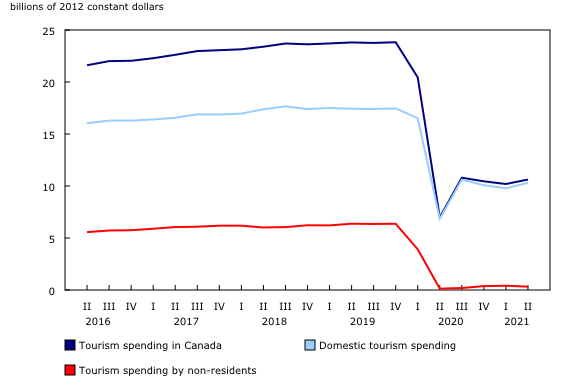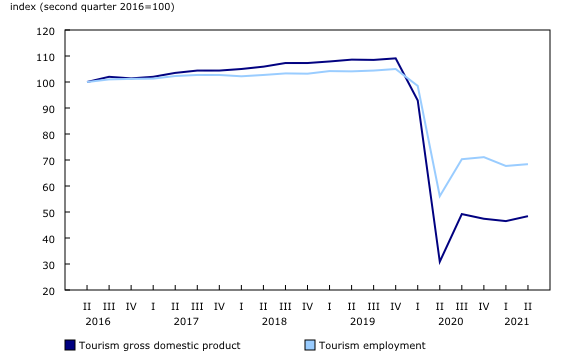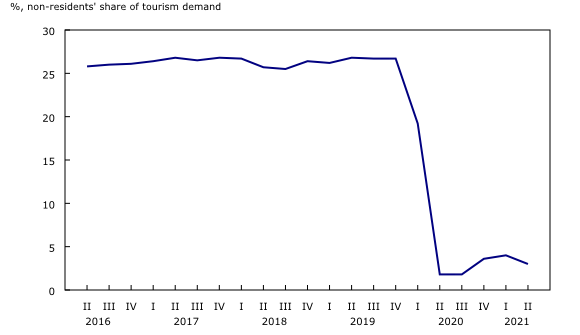National tourism indicators, second quarter 2021
Archived Content
Information identified as archived is provided for reference, research or recordkeeping purposes. It is not subject to the Government of Canada Web Standards and has not been altered or updated since it was archived. Please "contact us" to request a format other than those available.
Released: 2021-09-29
Tourism spending in Canada increased 4.2% in the second quarter, following a 2.5% decrease in the first quarter. Tourism gross domestic product (GDP) (+4.0%) and jobs attributable to tourism (+1.0%) also increased in the second quarter.
The COVID-19 pandemic had a continued economic impact in the second quarter. Throughout this period, restrictions were both expanded and eased in many regions, similar to the previous quarter. The vaccination campaign that began late in the fourth quarter of 2020 also ramped up throughout the second quarter of 2021.
The increase in tourism spending in the second quarter was mostly driven by spending on accommodation services (+6.1%) and food and beverage services (+4.3%). Overall, tourism spending in Canada in the second quarter was 55.4% lower than the pre-pandemic levels in the fourth quarter of 2019.
Tourism GDP rose 4.0% in the second quarter, following a 1.9% decline in the previous quarter. Economy-wide, GDP declined 0.3% in the second quarter, in large part due to falling exports and home ownership transfer costs, which did not have the same impact on the tourism sector.
Increases in accommodation (+4.5%), non-tourism industries (+3.0%) and food and beverage services (+3.8%) contributed most to the rise in tourism GDP in the second quarter.
Employment attributable to tourism increased 1.0% in the second quarter, following a 4.7% decline in the first quarter. Gains in food and beverage services (+3.1%) and in recreation and entertainment (+6.3%) more than offset the declines in air transportation (-8.5%) and travel services (-5.9%). Overall, employment growth in Canada was flat in the second quarter and tourism's share of employment remained at 2.4%.
Tourism spending in Canada by Canadians increases
Tourism spending in Canada by Canadians rose 5.4% in the second quarter, following a 2.9% decline in the previous quarter. Domestic spending on accommodation (+8.1%), food and beverage services (+5.1%) and passenger air transport (+13.4%) contributed the most to the increase.
With tourism spending by international visitors remaining at historic lows, the share of domestic tourism spending to total tourism spending was 97.0%, well above the pre-pandemic share of 73.3% observed in the fourth quarter of 2019.
Spending by international visitors remains low
Tourism spending by international visitors to Canada dropped 22.6% in the second quarter, continuing record low levels from the four previous quarters.
Air travel from abroad fell 32.4% and same-day car travel from the United States declined 12.7%.
New restrictions implemented in late February included a requirement for international travellers arriving in Canada by air to take a COVID-19 molecular test upon arrival and to stay in a government-authorized hotel while awaiting the results. These restrictions continued throughout the second quarter and may have contributed to the decline in international travellers by air.
Sustainable development goals
On January 1, 2016, the world officially began implementing the 2030 Agenda for Sustainable Development—the United Nations' transformative plan of action that addresses urgent global challenges over the next 15 years. The plan is based on 17 specific sustainable development goals.
The national tourism indicators are an example of how Statistics Canada supports the reporting on the global goals for sustainable development. This release will be used in helping to measure the following goal:

Note to readers
Growth rates for tourism spending and gross domestic product (GDP) are expressed in real terms (that is, adjusted for price changes), using reference year 2012, and are adjusted for seasonal variations, unless otherwise indicated.
Employment data are also seasonally adjusted.
Tourism's share of economy-wide employment is calculated using seasonally adjusted values.
For information on seasonal adjustment, see Seasonally adjusted data – Frequently asked questions.
Associated percentage changes are presented at quarterly rates, unless otherwise noted.
Economy-wide GDP is obtained from table 36-10-0104-01. Economy-wide employment is obtained from table 36-10-0207-01. Air travel from abroad and same-day car travel from the United States are obtained from table 24-10-0005-01.
Non-tourism industries, also referred to as other industries, are industries that would continue to exist in the absence of tourism. For example, the crop production and petroleum refineries industries produce products purchased by tourists. However, neither would cease to exist in the absence of tourism. Tourism GDP takes into account the production of these products purchased by tourists.
Non-tourism products, also referred to as other products, are products for which a significant part of its total demand in Canada does not come from visitors, such as groceries, clothing and alcohol bought in stores.
With this release of the national tourism indicators, all data from the first quarter have been revised.
Revisions over the 2020-to-2021 period are expected to be higher than normal due to the volatile economic situation, particularly for the tourism sector.
The national tourism indicators are funded by Destination Canada.
Next release
Data on the national tourism indicators for the third quarter of 2021 will be released on January 7, 2022.
Products
The document "The 1986 to 2020 revisions of the National Tourism Indicators," which is part of Latest Developments in the Canadian Economic Accounts (13-605-X), is now available.
The data visualization product "Provincial and Territorial Tourism Satellite Account," which is part of Statistics Canada – Data Visualization Products (71-607-X), is available.
The Economic accounts statistics portal, accessible from the Subjects module of our website, features an up-to-date portrait of national and provincial economies and their structure.
The User Guide: Canadian System of Macroeconomic Accounts (13-606-G) is available.
The Methodological Guide: Canadian System of Macroeconomic Accounts (13-607-X) is available.
Contact information
For more information, or to enquire about the concepts, methods or data quality of this release, contact us (toll-free 1-800-263-1136; 514-283-8300; STATCAN.infostats-infostats.STATCAN@canada.ca) or Media Relations (613-951-4636; STATCAN.mediahotline-ligneinfomedias.STATCAN@canada.ca).
- Date modified:






